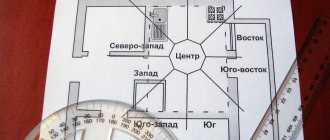Therefore, at 8:00:00 UTC, the mean solar time in the center of Moscow will be 8:00:00 + 2:30:28 = 10:30:28. From Greenwich Time you can calculate not only civil time in any time zone, but also local mean solar time on any meridian. For a modern city dweller, true time is rather an astronomical abstraction, which does not have much meaning in his life, since it is uneven (see Solar day).
In some countries, the official time for the summer period of the year is shifted forward by one hour. Our Earth is divided into 24 meridians of 15 degrees, each meridian is a time zone, and the time there is average.
Let's say you live in Moscow, where the geographic longitude is 37 degrees. In Moscow the current time zone is GMT+3 (after October 26, 2014). Multiply 15 degrees by 3 and get 45 degrees. Moscow is located at eastern longitude 37 degrees, 36′. For ease of calculation, in the example we will “round” the longitude to 37 degrees. The difference between the base meridian and the longitude of Moscow is approximately 45 - 37 = 8 degrees.
Local time
Time on the observer's meridian. It can be true solar, average solar and stellar.
True solar time (Ti)
Hour angle (angular distance measured along the celestial equator to the west of the celestial meridian, expressed in hourly units at the rate of 24 hours = 360o (1 hour = 15o, 1 minute = 15′). of the Sun, increased by 12 hours (measured west of celestial meridian). The moment the Sun crosses the meridian is called true noon. True solar time is shown by a simple sundial. To convert time to angular value and back, you can use the table:
Converting time to angular value and back
Mean solar time (MT)
Time measured by the hourly angle of some imaginary point, called the mean sun, moving uniformly along the equator, the position of which coincides with the center of the true Sun at the moments of the autumn and spring equinoxes. It differs from solar time due to the ellipticity of the earth's orbit and its inclination towards the equator. The difference between the mean solar time and the true solar time is equal to a correction called the equation of time (the current difference between the true and mean solar time), not exceeding 16 minutes, calculated theoretically and given in astronomical calendars. Average solar noon is 12 noon local time. The difference between the mean and true solar time or the difference between the right ascensions of the true and mean Sun is called the “equation of time”
.
Equation of time
Sidereal time (S)
Local sidereal time at the moment is numerically equal to the hour angle of the vernal equinox, also called the Aries point
. The time interval between two successive culminations of the same name on the vernal equinox on the same geographic meridian is called a sidereal day. A full rotation of the vernal equinox, like any other point on the celestial sphere, occurs in 23 hours 56 minutes 04 seconds of mean solar time, since the Sun, moving along the ecliptic, lags somewhat behind the daily rotation of the celestial sphere. A year contains exactly one more sidereal days than average solar days. A sidereal day is divided into sidereal hours, minutes and seconds. The sidereal day is 3 minutes 56 seconds shorter than the average solar day, the sidereal hour is 9.86 seconds shorter than the generally accepted one. Sidereal time is used in aviation astronomy when determining the lines of position and course of an aircraft by the stars or the location of an aircraft () using astronomical methods.
True solar time, Local Apparent Time (LAT)
The principle of operation of a sundial is based on the direction of the shadow cast by a vertical object - a gnomon . At noon, the shadow disappears or shows the direction strictly from north to south, the rest of the time the angle of the shadow gradually changes. By marking the sundial dial in a certain way, you can recognize the current time by the position of the gnomon's shadow. The oldest sundial, found in the Valley of the Kings, Egypt, dates back to the 13th century. BC. Even more ancient structures - the obelisks of Ancient Egypt (3rd millennium BC) are also considered the first gnomons that marked certain periods of the day. Local true solar time LAT is equal to the geocentric hour angle of the center of the visible disk of the Sun t, measured relative to the meridian of the observation site, plus 12 hours.
Standard time (Tp)
A time equal to the local civil time of the middle meridian of a given time zone. It is established by international agreement in regions and countries so that throughout the planet the difference between local time and universal time is an integer number of hours. To do this, the entire surface of the Earth is divided approximately along the meridians into 24 time zones. The average meridians of time zones pass at longitudes 15, 30, 45, ... degrees west of Greenwich along points on the earth's surface at which the mean solar time (MT), respectively, is 1, 2, 3, ... hours behind Greenwich. Typically, cities and their surrounding areas live according to the time of the nearest middle meridian. The lines dividing zones with different official times are called time zone boundaries. Usually they do not follow strictly along the meridians, but coincide with administrative boundaries.
International Atomic Time (TAI)
With the invention of atomic clocks, humanity received the most stable way to measure time. Since 1967, we have moved from ephemeris time to time measured by atomic clocks. They tried to make the second of atomic time exactly the same length as in the ephemeris scale, but expressed its definition in other terms: A second is a time equal to 9,192,631,770 periods of radiation corresponding to the transition between two hyperfine levels of the ground state of the cesium-133 atom. On January 1, 1958, atomic time corresponded to universal time. At this moment, the shift in ephemeris time (ET) was 32.184 s to universal time. Accordingly, TAI is expressed through ET as follows:
Time ratios
So, for each point on the Earth located at longitude X, you can indicate the local true solar time Ti; local mean solar time MT; standard time Tp; seasonal winter time Tz; seasonal summer time Tl; local sidereal time S. Here are the formulas for those who need to convert one time to another (due to maternity time, the last two formulas are correct for Russia):
- MT = Ti + t,
- MT = UTC + X,
- Tn = UTC + n,
- Tz = UTC + n + 1 h,
- T = UTC + n + 2 h,
- S = s + MT (approximately),
Where t is the equation of time; n — time zone number; s - sidereal time at Greenwich midnight (the sidereal time table is given in astronomical calendars).
Example: the longitude of Moscow X is 2 hours 30 minutes. Average solar noon is 12:00 local time (MT). According to world time it corresponds to UT = 12 hours - 2 hours 30 minutes = 9 hours 30 minutes, according to Moscow winter time - 12 hours 30 minutes, according to Moscow summer time - 13 hours 30 minutes.
Thus, if you are a resident of Moscow, then your time is 3 hours ahead of the world time in winter and 4 hours ahead in summer. But all of these, except for true solar time, are conditional points not directly related to real astronomical events. Only the time of sunrise, sunset and the moment of true noon, established with the help of a sundial directly at the right moment at the right point on the Earth, have a real connection with cosmic processes. (although, to be completely accurate, the true sunrise occurs 5 minutes later than observed, and the true sunset occurs 5 minutes earlier due to the phenomenon of atmospheric refraction).
Coordinated Universal Time (UTC)
The traditional method of measuring time by the rotation of the Earth is familiar to everyone, but is not stable due to the uneven rotation of the Earth. Atomic time is stable, but after years it noticeably diverges from universal time. In order to obtain a stable time tied to the change of day and night on Earth, they decided to create a scale, the unit of which would be the stable atomic second, but occasionally the 61st second would be added (or the 60th would be removed), so that the difference between this time and the universal did not exceed 0.9 seconds. The time is called universal coordinated UTC. The International Earth Rotation Service (IEO) publishes daily the difference between Universal Time and Coordinated Time ΔUT, as well as a list and dates for the introduction of leap seconds. There are several versions of universal time. The WSWS publishes the difference ΔUT1 between UT1 and UTC. UT1 is currently the main version of universal time, the value of which is determined from distant quasars using very long baseline radio interferometry (VLBI). Accordingly, other versions of universal time have almost fallen out of use: UT0 and UT2. UT0 was the original UT based on observations at a specific observatory. UT0 does not take into account the effect of pole shift, which means that different observing stations will receive different values. Since the 80s of the last century, the UT0 value has ceased to be monitored by all observatories. In our calculator, the value of UT0 is derived from the relation: UT1= UT0−(xp sin λ + yp cos λ ) tan ϕ where xp, yp are the coordinates of the instantaneous pole relative to the conventional international origin, ϕ, λ are the coordinates of the observation point UT2 is universal time without taking into account seasonal annual fluctuations in the rotation of the Earth. Calculated by the formula: UT2 = UT1+0.0220 sin2πθ − 0.0120 cos 2πθ − 0.0060 sin 4πθ + 0.0070 cos 4πθ, where θ = 2000.0+ (JD − 2451544, 533)/365, 2422, JD—Julian date of observation
Time in FS2004
Time in FS2004 is calculated using GMT in full accordance with astronomy. Time zones change every 15 degrees of longitude. Accordingly, the calculation of zone (winter, summer) time must be done independently according to location and GMT time. Additional utilities or scripts are used to set the simulator time to standard time (see Links). But it must be remembered that, in some cases, due to such utilities, the operation of some devices, traffic and other time-related applications will look different than without them.
True time is determined by the position of the sun
Denis, good day! Thank you for your work. I come to you with a request, please check me too! 10×15=150 degrees. 150-143=7.7×4=28 minutes. This is the difference between local time and solar time. But should it be subtracted or added to local time? In fact, all time translations are taken into account, and on the basis of this, the territory is assigned one or another time zone (GMT+).
I live in Baku. I tried to calculate the difference with solar time. I live in Novokuznetsk, Kemerovo region. I'm confused about summer/winter time in our region. In Kirov, as in many other cities of the Volga region, time is not native, but Moscow, which was switched to during perestroika. In Soviet times, the day in the Volga region began an hour earlier than in Moscow.
Unity of two luminaries
In most countries, their time constitutes a single system of life in harmony with nature. As mentioned earlier, the solar cycle determined seasonal activity, and the cycle of the night guest determined everyday and everyday activity. By the way, we should not forget that the lunar calendar is also used in Orthodoxy to calculate such a great holiday as Easter.
Solar and lunar time affect us differently. It has been established that living in accordance with the rhythms of the luminaries is very useful. This makes a person more disciplined, consistent, and more emotionally stable. First of all, this is useful for children, because their body is least protected from stress, which undermines the immune system that has not yet formed. It is especially important to maintain a sleep schedule; chronic lack of sleep has become commonplace, and this is not a good sign. Adequate sleep has the ability to treat many diseases.
Lunar time is responsible for the emotional state. The sun can also affect a person.
From time to time, activity occurs on it, during which powerful plasma emissions occur that affect the magnetosphere of our planet. During this time, many people may feel unwell. On the Internet you can find out the degree of solar activity in real time and prepare in advance for its surges.
How to tell time by colors
Plants are sensitive to changes in daylight hours. Carl Linnaeus invented a small circuit that could be used to measure time.
Salsify plant
What time do the flowers open (in hours)?
In the morning:
- 3-5 – salsify;
- 4-5 – chicory;
- 5 – sow thistle;
- 5-6 – dandelion;
- 6 – hawkweed;
- 6-7 – alyssum;
- 7 – water lily, lettuce;
- 7-8 – full color, tunic;
- 9-10 – marigolds.
In the evening:
- 20 – red day;
- 21 – tobacco.
Plant Full Bloom
What time do flowers close?
In the morning:
- 8-10 – dandelion;
- 10 – chicory;
- 10-11 – full-time color;
- 11-12 – sow thistle;
- noon – marigolds.
Plant
during the day:
- 13 – tunic, hawk;
- 15-16 – corolla;
In the evening:
- 17 – water lily;
- 19-20 – red day.
LHow to heal with plants while hiking, read the article: Herbal medicine while hiking: what herb stops bleeding and how to disinfect a wound, how to cure a cold
What now?
You may be interested in: Combustible substances and their characteristics
Scientific and technological progress gradually alienated people from the natural rhythm of nature and the stars. Currently, everything has become mixed up, the regime and rhythms have shifted in time, and life has accelerated many times over, and the attitude towards the solar cycle has become freer. The introduction of technical innovations into life, on the one hand, has simplified a person’s life, but on the other hand, it has made his life physically inactive, but more active in terms of nervous activity. The development of cities and megalopolises often forces us to live in an eternal race. The concept of “solar time” has lost its significance over the years.
However, genetics has not gone away; fatigue with such a life inspires people to be in nature, in forests, and near water bodies as often as possible. Because it is communication with nature that can restore the energy lost in the constant bustle. And a daily routine close to sunny can add stability to a harmonious mood.
Solar energy, man and the seasons
You may be interested in: Gulf of Anadyr: location, description, climatic features
It is recommended to remember how the villagers lived before.
In spring, people's activity increases. The sun lingers longer and longer above the horizon. At this time, field work always began; animals and birds, having spent the winter in pens, spent more and more time in the wild; work began in full swing on improving their homes and plots. In the summer, energy output reached its maximum, people not only worked actively, but also actively had fun.
With the onset of autumn, preparations began for the period of least solar activity, the collection of fruits, berries and grains ended, and reserves were created for the long, cold winter. During the period of cold weather and snow, human activity, like the light, was calm. Everyone preferred to spend most of their time in their cozy houses, closer to the Russian stove, only sometimes this calm was interrupted by winter joys, for example, sleigh rides or snowball fights. And then the cycle repeated all over again. It should be noted that people’s daily routine at that time completely coincided with the sun’s: they rested at nightfall and woke up at dawn.
Julian days
Astronomers have adopted a certain serial numbering of days. It has a cycle of 28 years. In it, all days and weeks are repeated.
Julian calendar
This measurement method was developed by John Herschel in 1849. The counting of time began at noon on April 1 from 4713 BC. Joseph Scaliger suggested using it. By the way, he called it Julian, in honor of Father Julius
John Herschel
“The universe and time are infinite. This means that any event is inevitable, even the impossible” from the film Route 60
Recommendations
- Astronomical almanac Internet.
Archived November 8, 2015, at the Wayback Machine (2011), at Her Majesty's Nautical Almanac Office and the United States Naval Observatory. Glossary of solar time. - Leap seconds. Archived March 12, 2015, at the Wayback Machine (1999). Department of Time Services, US Naval Observatory.
- Regarding the three kinds of time, see (For example) the explanatory section in the almanac Connaissance des Temps for 1902, page 759. Archived August 10, 2011 at the Wayback Machine.
- Celestial Mechanics Chapter 6 Archived 2015-09-23 at the Wayback Machine, J.B. Tatum, University of Victoria
- ↑
Online astronomical almanac archived September 14, 2008 at the Wayback Machine (2010). United States Naval Observatory. sv solar time, apparent; daytime traffic; apparent place. - Yallop, B. D. and Hohenkerk, C. Y. (August 1989). Diagram of the location of the Sun. Archived December 24, 2010, at the Wayback Machine (astronomical information sheet #58). HM Nautical Almanac Office.
- Ellison, Michael; Schmunk, Robert (30 June 2015). "Technical notes on Mars solar time as adopted by the Mars24 sundial". Goddard Institute for Space Studies
. National Aeronautics and Space Administration. Archived from the original on September 25, 2015. Retrieved October 8, 2015. - Ellison, Michael; McEwen, Megan (2000). "Post-Pathfinder Estimation of Areocentric Solar Coordinates with Improved Temporal Recipes for Seasonal/Diurnal Climate Studies of Mars". Planetary and Space Science
.
48
(2–3): 215. Bibcode: 2000P & SS ... 48..215A. DOI: 10.1016/S0032-0633 (99) 00092-6. LVP: 2060/20000097895. Archived June 23, 2015. - ^ab Jean Meeus (1997), Pieces of Mathematical Astronomy
(Richmond, VA: Willmann-Bell) 346. ISBN 0-943396-51-4. - Hilton, James L; McCarthy, Dennis D. (2013). "Precession, nutation, polar motion and rotation of the Earth." In Urbana, Sean E.; Seidelmann, P. Kenneth (eds.). Explanatory supplement to the astronomical almanac
(3rd ed.). Mill Valley, CA: University Science Books. ISBN 978-1-891389-85-6. - Jump up
↑ McCarthy, D. D. & Seidelmann, P. K. (2009).
TIME From the rotation of the Earth to atomic physics.
Weinheim: Wiley-VCH Verlag GmbH & Co. KGaA. ISBN 978-3-527-40780-4. pp. 68, 326. - Jump up
↑ Capitaine, N., Wallace, P.T., & McCarthy, D.D. (2003).
"Expressions for implementing the IAU 2000 definition of UT1". Archived 07 April 2016 at the Wayback Machine, Astronomy and Astrophysics
, vol.406 (2003), pp.1135-1149 (or pdf);
and for some earlier definitions of UT1 see Aoki, S., H Kinoshita, H., Guinot, B., Kaplan, G.H., D.D. McCarthy, D.D., & Seidelmann, P.K. (1982) "Universal time redefined", Astronomy and Astrophysics
, vol.105 (1982), pp. 359-361. - For a discussion of small changes affecting the average solar day, see the article ΔT.
- ↑
"The duration of a real sunny day." Archived August 26, 2009 at the Wayback Machine. Pierpaolo Ricci. pierpaoloricci.it. (Italy) - Meeus, J. (1998). Astronomical algorithms.
2nd ed. Richmond WA: Willmann-Bell. paragraph 183. - : (1) In “The Physical Basis of the Leap Second” by D.D. McCarthy, C. Hackman and R. A. Nelson in the Astronomical Journal, volume 136 (2008), pages 1906-1908, states (page 1908) that "the SI second is equivalent to the older UT1 second measurement, which was too small to begin with, and further, as the duration of the UT1 second increases, the discrepancy increases.” : (2) In the late 1950s, the cesium standard was used to measure both the current average length of the second of mean solar time (UT2) (result: 9192631830 cycles) and the second of ephemeris time (ET) (result: 9192631770 ± 20 cycles), see “Time Scales” by L. Essen. Archived October 19, 2008, at the Wayback Machine., in Metrologia, volume 4 (1968), pp. 161-165, p. 162. As is well known, the digit 9192631770 was chosen for the second SI. L. Essen, in the same 1968 paper (p. 162), stated that this "seemed reasonable given the variations in UT2."










